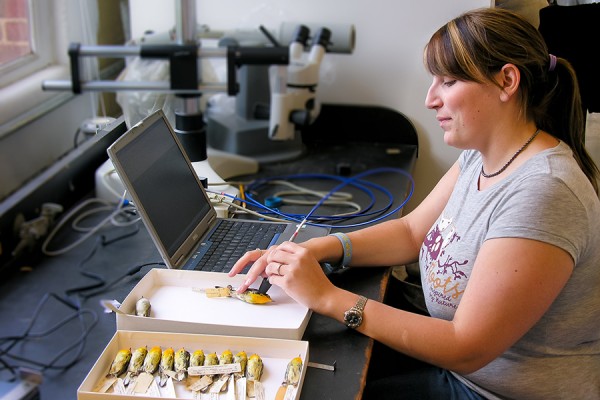 Allison Mistakidis, a former Master’s student in the laboratory of biology professor Stéphanie Doucet, uses a spectrophotometer to measure the plumage colour of a museum specimen of a warbler.
Allison Mistakidis, a former Master’s student in the laboratory of biology professor Stéphanie Doucet, uses a spectrophotometer to measure the plumage colour of a museum specimen of a warbler.
Animals exhibit a tremendous diversity of colours and sounds, but closely related species often have similar characteristics, such as leopards and jaguars. When related species occur in the same geographic area, however, they may instead possess distinctive features that serve as signals of species identity.
A new investigation, published Wednesday in the scientific journal Proceedings of the Royal Society B, explores how geographic overlap might impact two common bird characteristics: feather colour and song. The University of Windsor research team measured the feather colour and songs of 90 species of North American warblers. The results show that birds with more overlap in geographic range exhibit greater differences in feather colouration, but more similar songs.
“Our research is unique because we demonstrate that overlapping geographic ranges impacts how two different signals evolve,” says Rick Simpson, a post-doctoral fellow at the University of Windsor and the lead author of the study.
According to Stéphanie Doucet, the senior author of the study: “our findings suggest that feather colouration is likely an important signal of species identity in North American warblers.”
The authors used state-of-the-art instruments to measure the feather colour of specimens from natural history museums for each of the 90 species of songbirds. Next, they measured the acoustic features of the songs of these same species. The team of five researchers then compared plumage and song features to the geographic ranges of the birds.
“We were surprised to find that bird songs were more similar when two species had highly overlapping ranges,” said biology professor Dan Mennill, who contributed his bioacoustic expertise to the investigation. “Bird species with highly overlapping ranges have more similar songs even though their feather colours are different. We speculate that different forces shape the evolution of song, such as selection for enhanced transmission through similar habitats.”
Another interesting finding from this new study concerns crowding. When more species of warbler co-occur in a geographic area, it is harder for them to stand out from one another.
“Think about trying to distinguish yourself from other people at a costume party. If there are only a few people in that room, it is easy to stand out! But if that party is very crowded, you are more likely to have a similar costume to someone else,” explained Dr. Simpson.
“These bird signals work the same way. For example, there are only so many colours in the palette of bird feathers, and if there are 30 or more species all in the same geographic area, it is much harder for them to appear different than if there are only two or three species.”
Overall, the study illustrates the complex ways in which bird communication signals can be affected by overlap in their geographic range. This work by Simpson and his colleagues provides important new insight into how bird signals, especially feather colour, became so diverse.
